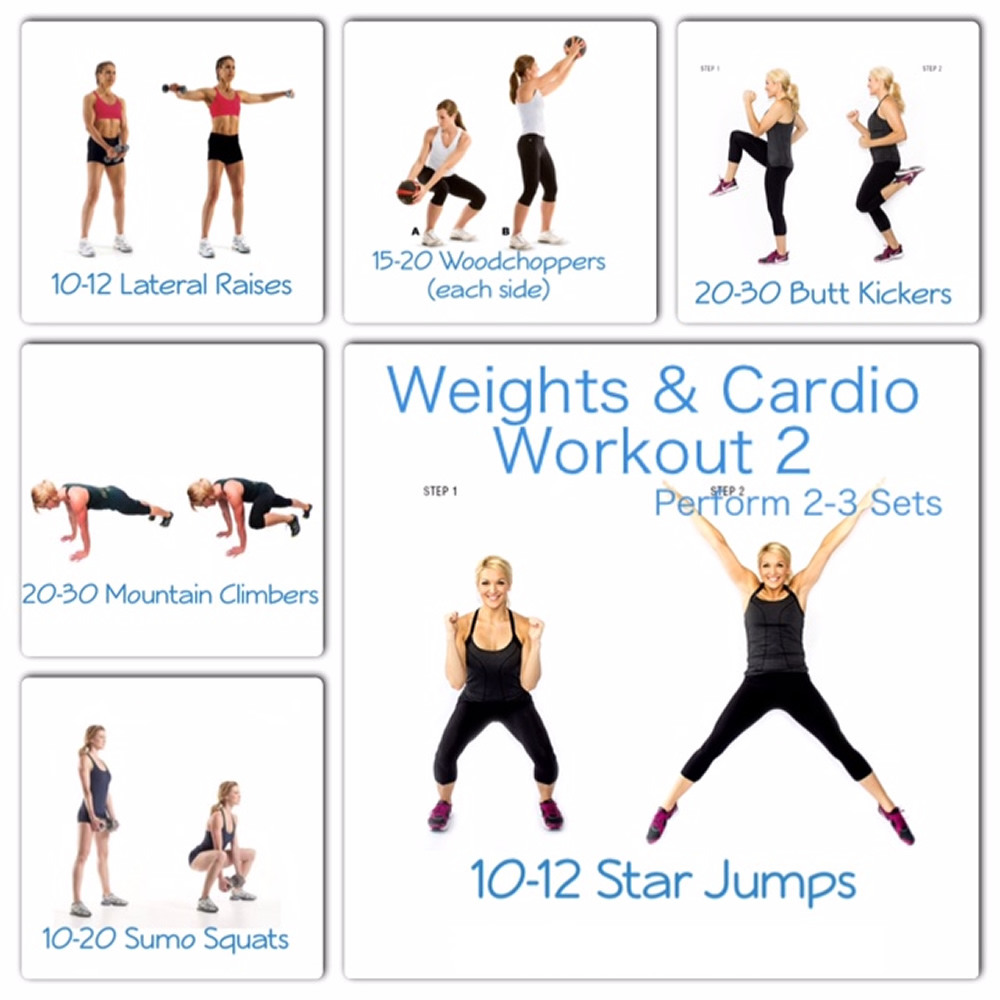Contents
- What is High Intensity Interval Training
- Benefits of high-intensity interval training (HIIT)
- How To Develop Your Own High-Intensity Interval Training (HIIT) Exercise Program
- Example of High-Intensity Interval Training (HIIT) Workout
- How Many Times a Week Can You do a High-Intensity Interval Training (HIIT) Workout ?
- What are the Safety Concerns with high-intensity interval training (HIIT) Training ?
- How High-intensity interval training (HIIT) works
- High-intensity Aerobic Training can Reverse Aging processes in Adults
- High-Intensity Interval Resistance Training (HIRT) could play a role in Weight Control
- Effects of High Intensity Interval Training on Cardiorespiratory Fitness and implications for Hypertension
- High intensity interval training Improves Liver and Adipose tissue Insulin Sensitivity
- What can High Intensity Interval Training (HIIT) do for you ?
- High Intensity Interval Training Workouts for Beginners
What is High Intensity Interval Training
While not exactly new, high-intensity interval training (HIIT) is emerging as an effective and more time-efficient alternative to traditional endurance-based exercise programs – for a time-constrained society. High intensity interval training programs include short bursts of high-intensity activity performed at maximal effort (80-95 percent peak oxygen intake or VO2 max), separated by short periods of low-intensity work that allow partial recovery. The recovery periods may last equally as long as the work periods and are usually performed at 40% to 50% of a person’s estimated maximal heart rate. The workout continues with the alternating work and relief periods totaling 20 to 60 minutes. Two HIIT sessions a week is plenty, in addition to your other workouts.
High-intensity interval training (HIIT), in a variety of forms, is today one of the most effective means of improving cardiorespiratory and metabolic function and, in turn, the physical performance of athletes 1. Recent evidence suggests that – in young healthy persons of average fitness – intense interval exercise is a time-efficient strategy to stimulate a number of skeletal muscle adaptations that are comparable to traditional endurance training. As little as six sessions of HIIT over 2 wk or a total of only approximately 15 min of very intense exercise (approximately 600 kJ), can increase skeletal muscle oxidative capacity and endurance performance and alter metabolic control during aerobic-based exercise. 2. By incorporating a high-intensity interval training workout into your general exercise program will optimize the development of your cardiorespiratory fitness as well as numerous other health benefits.
Benefits of high-intensity interval training (HIIT)
One of the main benefits of HIIT is adaptability – unlike many more specialized workouts, it can easily be modified for all fitness levels, as well as special conditions including diabetes and overweight populations. And, HIIT programs can be built around many exercise modes, from biking, to swimming, to group exercise classes 3. Fitness-wise, because of their vigorous nature, HIIT workouts burn more calories after a session is over than other traditional workouts. Studies have shown that high-intensity interval training (HIIT) workouts has been shown to improve 4:
- aerobic and anaerobic fitness
- blood pressure
- cardiovascular health
- insulin sensitivity (which helps the exercising muscles more readily use glucose for fuel to make energy)
- cholesterol profiles
- abdominal fat and body weight while maintaining muscle mass.
High-intensity interval training (HIIT) may be an extremely effective and efficient means by which to increase an your VO2max, a well-established marker of cardiopulmonary health. When high-intensity interval training (HIIT) protocols have been compared with traditional steady state protocols in the laboratory, high-intensity interval training (HIIT) elicits similar and sometimes greater gains in VO2max, despite significantly lower exercise volume 5, 6, 7.
High-intensity interval training (HIIT) can be an efficient approach to decreasing insulin resistance as well — a major factor in developing type 2 diabetes. Positive changes have been observed in insulin resistance in as little as 8 minutes per week when executed at an intensity more than 100% VO2max 8.
High-intensity interval training involves repeated short (<45 seconds) to long (2-4 minutes) bouts of rather high-intensity exercise interspersed with recovery periods. A typical high-intensity interval training session might include a three-minute warmup, four to six repetitions of a 30-second sprint followed by a 60-second active recovery, and a three-minute cool-down 9. High intensity interval training is not as complicated as you might think. Interval training is simply alternating bursts of intense activity with intervals of lighter activity. For instance, if your exercise is walking — if you’re in good shape, you might incorporate short bursts of jogging into your regular brisk walks. If you’re less fit, you might alternate leisurely walking with periods of faster walking. For example, if you’re walking outdoors, you could walk faster between certain mailboxes, trees or other landmarks. While athletes have used ‘classical’ HIIT formats for nearly a century (e.g. repetitions of 30 s of exercise interspersed with 30 s of rest, or 2-4-min interval repetitions ran at high but still submaximal intensities), there is today a surge of research interest focused on examining the close relationship between exercise intensity performed and cardiorespiratory fitness.
Prescription for high-intensity interval training consists of the manipulation of up to nine variables, which include:
- promote strength development for all major muscle groups of the body,
- create a balance of strength throughout the body (e.g., you would not want to prescribe five exercises for one body part while only prescribing one for another; creating a balance of strength around a joint is an effective way to prevent injury and improve movement efficiency,
- the work interval intensity and duration,
- relief interval intensity and duration,
- exercise modality,
- number of repetitions,
- number of series,
- be immediately modified or adapted as necessary to increase or decrease exercise intensity,
- be easily transitioned to accommodate minimized rest time as well as the between-series recovery duration and intensity.
The manipulation of any of these variables can affect the acute physiological responses to high-intensity interval training.
High-intensity interval training (HIIT) training can easily be modified for people of all fitness levels and special conditions, such as overweight and diabetes. High-intensity interval training (HIIT) workouts can be performed on all exercise modes, including cycling, walking, swimming, aqua training, elliptical cross-training, and in many group exercise classes. High-intensity interval training (HIIT) workouts provide similar fitness benefits as continuous endurance workouts, but in shorter periods of time. This is because HIIT workouts tend to burn more calories than traditional workouts, especially after the workout. The post-exercise period is called “EPOC”, which stands for “excess postexercise oxygen consumption” 4. This is generally about a 2-hour period after an exercise bout where the body is restoring itself to pre-exercise levels, and thus using more energy. Because of the vigorous contractile nature of high-intensity interval training (HIIT) workouts, the EPOC generally tends to be modestly greater, adding about 6 to 15% more calories to the overall workout energy expenditure.
Total Exercise Time
Research has demonstrated that improvements can be made in VO2max and insulin sensitivity in as little as 4 minutes of total exercise time in a high-intensity interval training (HIIT) session 10, 7. However, it is to be noted that this result often requires working at intensities equivalent to greater than 100% of VO2max 7.
More moderate protocols (90% to 100% of VO2max) have been examined for various total exercise durations 10. Although these protocols seem to require slightly more total exercise time to be effective, they still are well below the steady state exercise time requirements.
Because most individuals may not be able to execute the program at an intensity significantly greater than 100% of their VO2max, following the established American College of Sports Medicne guidelines for high-intensity exercise of at least 20 minutes is recommended 11. This may require multiple repetitions (or circuits) of a multistation exercise circuit.
How To Develop Your Own High-Intensity Interval Training (HIIT) Exercise Program
When developing a high-intensity interval training (HIIT) program, consider the duration, intensity, and frequency of the work intervals and the length of the recovery intervals. Intensity during the high intensity work interval should range ≥ 80% of your estimated maximal heart rate. As a good subjective indicator, the work interval should feel like you are exercising “hard” to “very hard”. Using the talk test as your guide, it would be like carrying on a conversation, with difficulty. The intensity of the recovery interval should be 40-50% of your estimate maximal heart rate. This would be a physical activity that felt very comfortable, in order to help you recover and prepare for your next work interval. The original circuit training protocols called for 9 to 12 exercise stations. There is no ideal number of exercise stations; however, it is important that, for a general program, all muscles are used at an appropriate intensity during a training session. The number of exercise stations also will affect the total exercise time.
Exercise Order: Exercises in a high-intensity interval training (HIIT) circuit should be placed in an order that allows for opposing muscle groups to alternate between resting and working in subsequent exercise stations. For example, a push-up (upper body) station would be followed by a squat (lower body) station. While the participant is performing push-ups, the lower body is not being used significantly and can somewhat recover. This allows for the lower body to have sufficient energy to perform squats with proper form and technique and at adequate intensity.
If a particular exercise creates a significant increase in heart rate or intensity demand (usually dynamic exercises incorporating the lower body or whole body), the next exercise functions to decrease heart rate or intensity slightly. For example, a stationary plank or abdominal crunches may follow jumping squats.
The objective is to allow for a series of exercises to be performed in quick succession — using proper form and technique — and at high intensity with minimal rest between exercises.
The relationship of the work and recovery interval is important. Many studies use a specific ratio of exercise to recovery to improve the different energy systems of the body. For example, a ratio of 1:1 might be a 3-minute hard work (or high intensity) bout followed by a 3-minute recovery (or low intensity) bout. These 1:1 interval workouts often range about 3, 4, or 5 minutes followed by an equal time in recovery – repeating this cycle 3 to 5 times.
Another popular HIIT training protocol is called the “spring interval training method” 4. With this type of program the exerciser does about 30 seconds of ‘sprint or near full-out effort’, which is followed by 4 to 4.5 minutes of recovery. This combination of exercise can be repeated 3 to 5 times. These higher intensity work efforts are typically shorter bouts (30 seconds with sprint interval training). There is even a well-researched workout made up of 8 second work and 12 second rest intervals for 20 minutes!
The basic way to calculate your maximum heart rate is to subtract your age from 220. For example, if you’re 45 years old, subtract 45 from 220 to get a maximum heart rate of 175. This is the maximum number of times your heart should beat per minute during exercise.
Maximum Heart Rate = 220 – Age
- For moderate-intensity physical activity, a person’s target heart rate should be 50 to 70% of his or her maximum heart rate. This maximum rate is based on the person’s age. An estimate of a person’s maximum age-related heart rate can be obtained by subtracting the person’s age from 220. For example, for a 50-year-old person, the estimated maximum age-related heart rate would be calculated as 220 – 50 years = 170 beats per minute (bpm). The 50% and 70% levels would be:
- 50% level: 170 x 0.50 = 85 bpm, and
70% level: 170 x 0.70 = 119 bpm
Thus, moderate-intensity physical activity for a 50-year-old person will require that the heart rate remains between 85 and 119 bpm during physical activity.
- For vigorous-intensity physical activity, a person’s target heart rate should be 70 to 85% of his or her maximum heart rate. To calculate this range, follow the same formula as used above, except change “50 and 70%” to “70 and 85%”. For example, for a 35-year-old person, the estimated maximum age-related heart rate would be calculated as 220 – 35 years = 185 beats per minute (bpm). The 70% and 85% levels would be:
- 70% level: 185 x 0.70 = 130 bpm, and
85% level: 185 x 0.85 = 157 bpm
Thus, vigorous-intensity physical activity for a 35-year-old person will require that the heart rate remains between 130 and 157 bpm during physical activity.
- Taking Your Heart Rate
Generally, to determine whether you are exercising within the heart rate target zone, you must stop exercising briefly to take your pulse. You can take the pulse at the neck, the wrist, or the chest. We recommend the wrist. You can feel the radial pulse on the artery of the wrist in line with the thumb. Place the tips of the index and middle fingers over the artery and press lightly. Do not use the thumb. Take a full 60-second count of the heartbeats, or take for 30 seconds and multiply by 2. Start the count on a beat, which is counted as “zero.” If this number falls between 85 and 119 bpm in the case of the 50-year-old person, he or she is active within the target range for moderate-intensity activity.
Example of High-Intensity Interval Training (HIIT) Workout
The following is an example of a 12-station High-intensity interval training (HIIT) program 12. All exercises can be done with body weight and implements easily acquired in almost any setting (e.g., home, office, hotel room, etc.). The exercise order allows for a total body exercise to significantly increase the heart rate while the lower, upper, and core exercises function to maintain the increased heart rate while developing strength.
Exercises are performed for 30 seconds, with 10 seconds of transition time between bouts. Total time for the entire circuit workout is approximately 7 minutes. The circuit can be repeated 2 to 3 times.
1. Jumping Jacks Total body

2. Wall sit Lower body
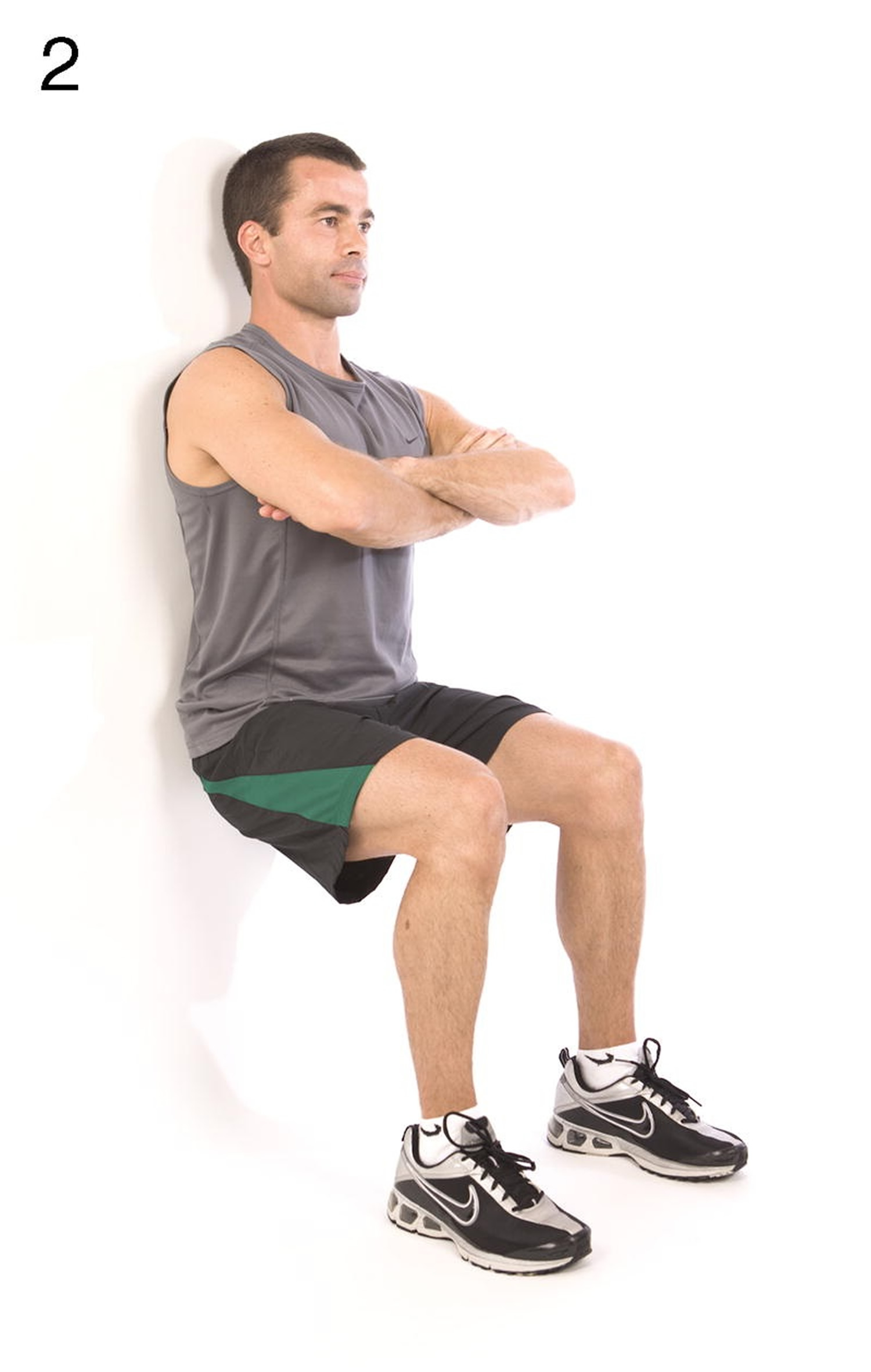
3. Push-up Upper body

4. Abdominal crunch Core

5. Step-up onto chair Total body
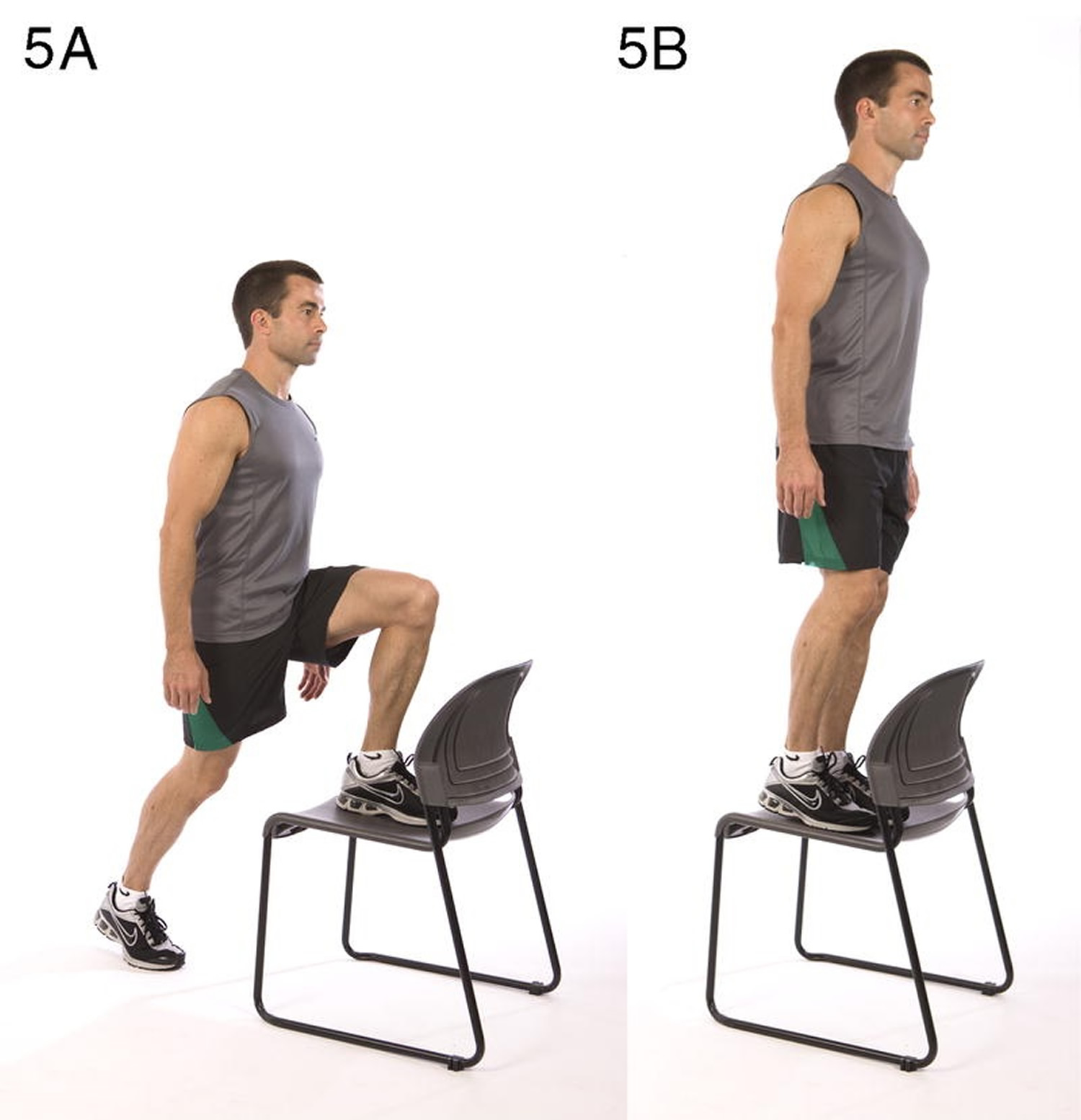
6. Squat Lower body

7. Triceps dip on chair Upper body
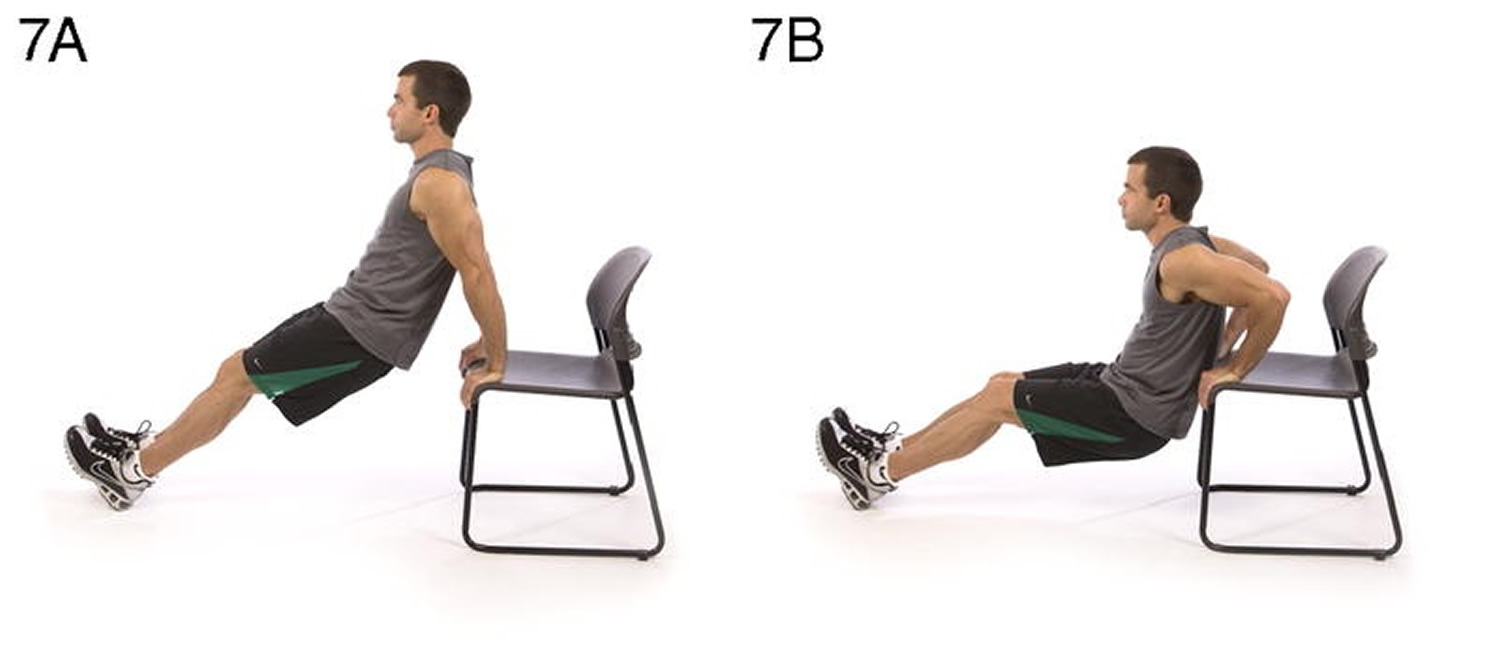
8. Plank Core
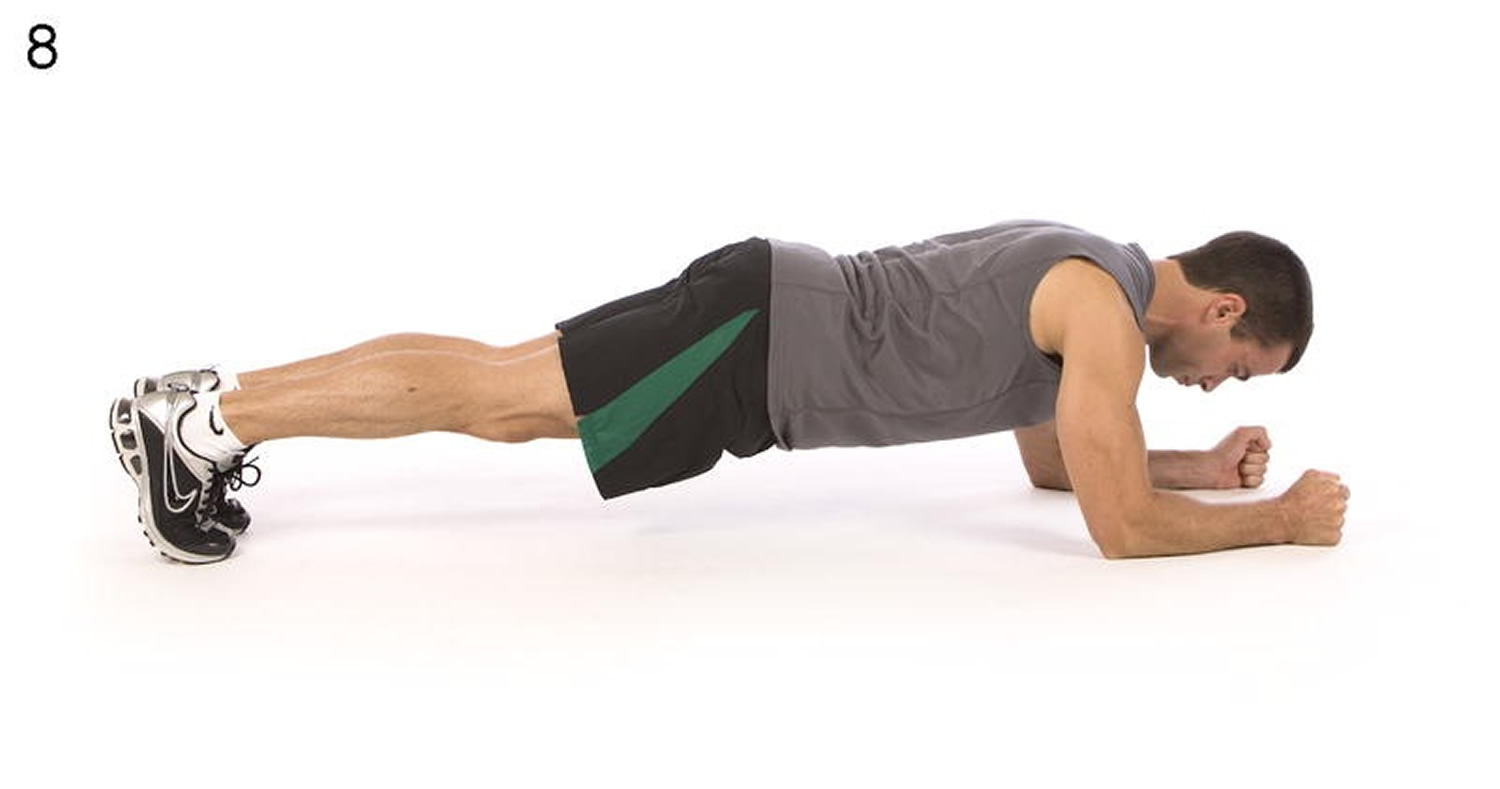
9. High knees running in place Total body
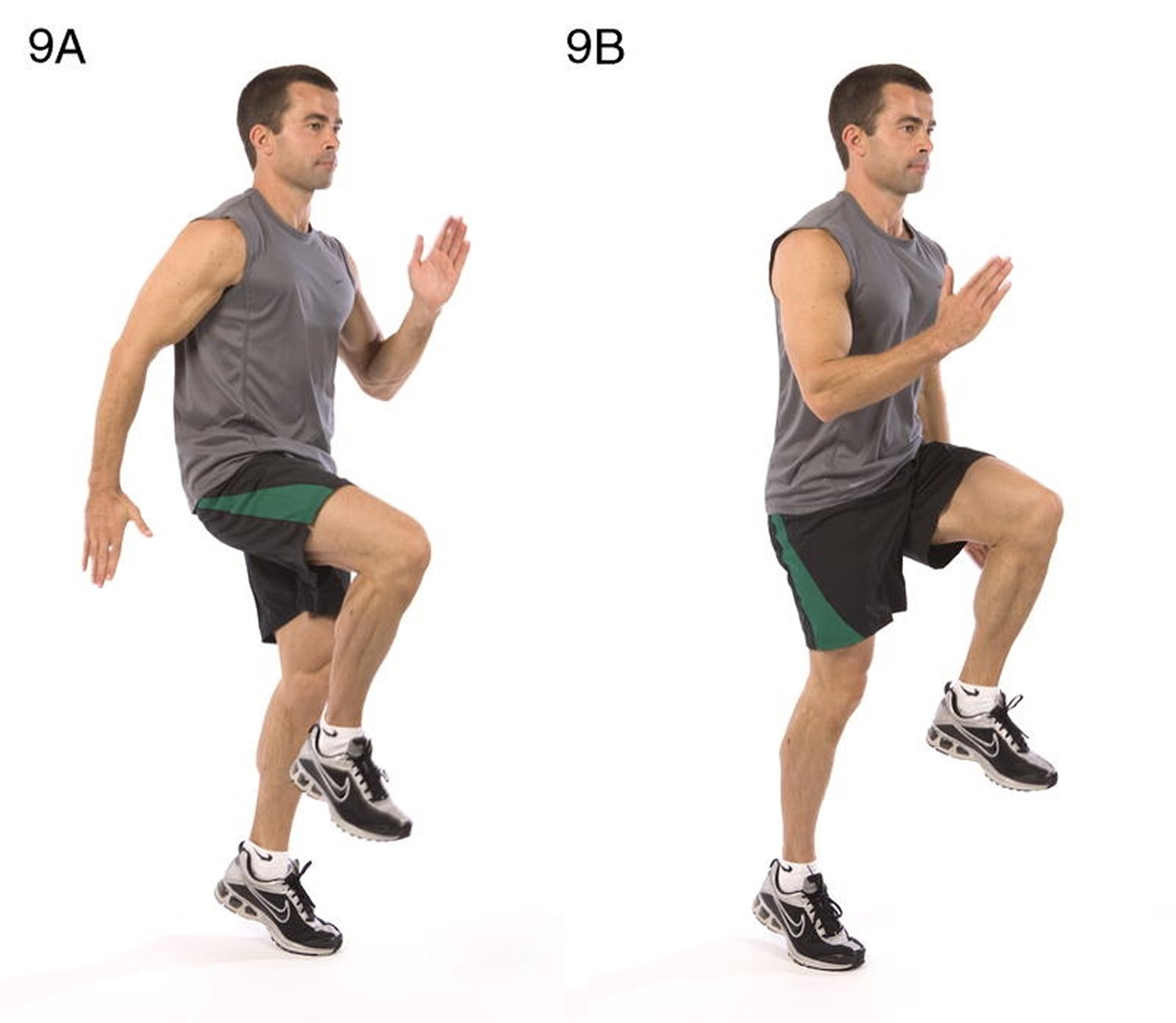
10. Lunge Lower body

11. Push-up and rotation Upper body
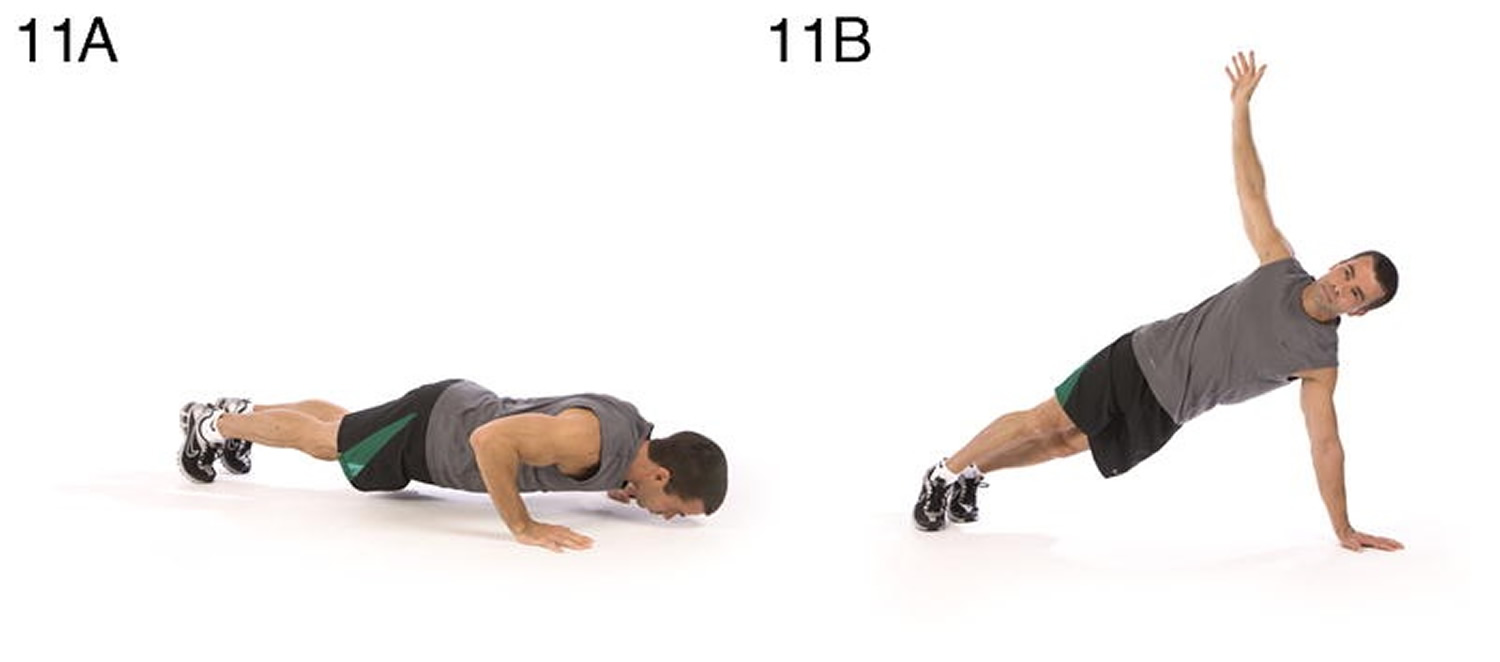
12. Side plank Core
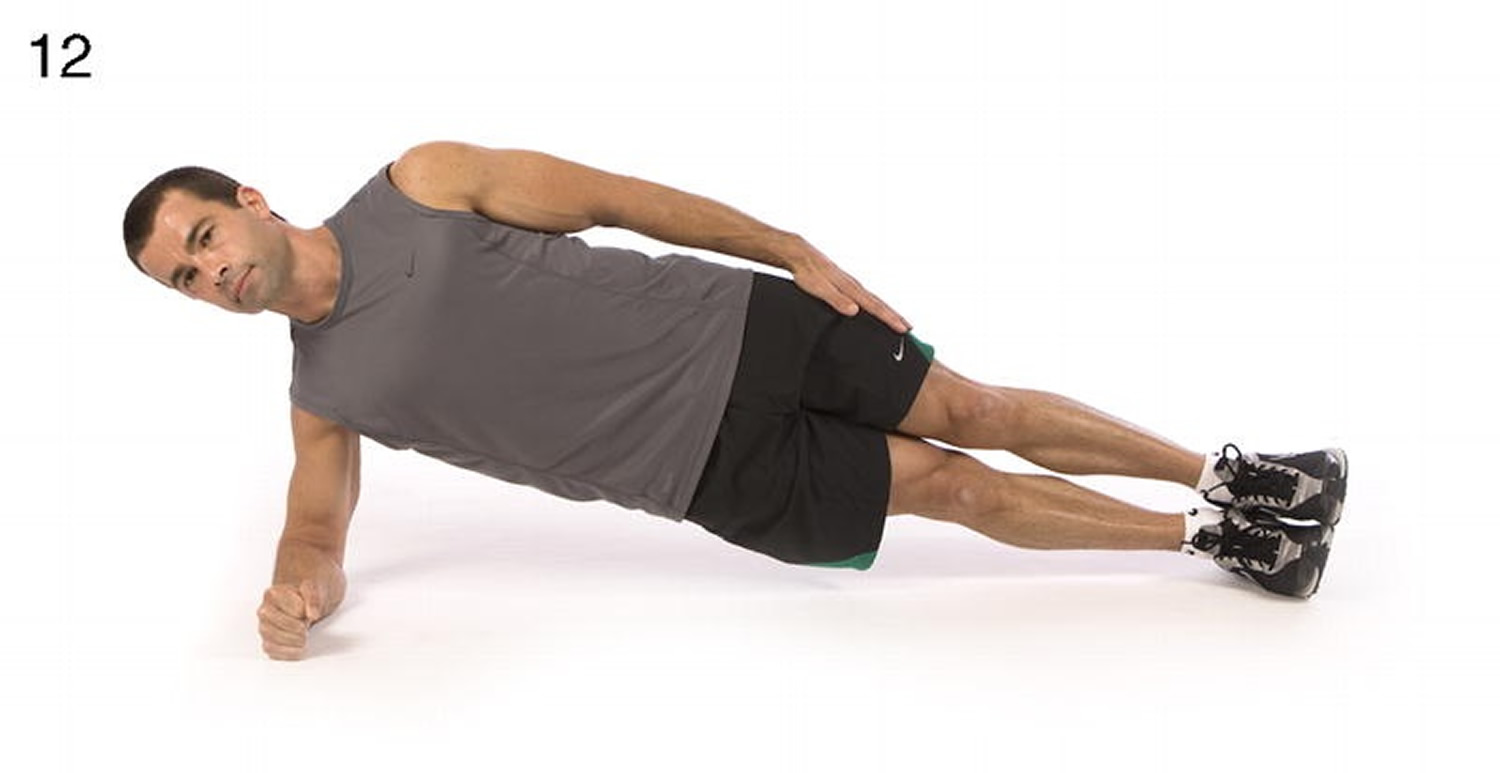
How Many Times a Week Can You do a High-Intensity Interval Training (HIIT) Workout ?
High-intensity interval training (HIIT) workouts are more exhaustive then steady state endurance workouts. Therefore, a longer recovery period is often needed. Perhaps start with one HIIT training workout a week, with your other workouts being steady state workouts. As you feel ready for more challenge, add a second HIIT workout a week, making sure you spread the HIIT workouts throughout the week.
What are the Safety Concerns with high-intensity interval training (HIIT) Training ?
To reduce your risk of injury, it’s important to establish exercise form, muscle strength, and range of motion before starting an HIIT program. And – the intensity of the workout should be modified to your own preferred challenging level. Don’t focus on keeping up with others – find the personal level of training that’s optimal for you instead. People who have been living rather sedentary lifestyles or periods of physical inactivity may have an increased coronary disease risk to high intensity exercise. Family history, cigarette smoking, hypertension, diabetes (or pre-diabetes), abnormal cholesterol levels and obesity will increase this risk. Medical clearance from a physician may be an appropriate safety measure for anyone with these conditions before staring HIIT or any exercise training. Prior to beginning HIIT training a person is encouraged to establish a foundational level of fitness. This foundation is sometimes referred to as a “base fitness level”. A base fitness level is consistent aerobic training (3 to 5 times a week for 20 to 60 min per session at a somewhat hard intensity) for several weeks that produces muscular adaptations, which improve oxygen transport to the muscles. Establishing appropriate exercise form and muscle strength are important before engaging in regular HIIT to reduce the risk of musculoskeletal injury. Regardless of age, gender and fitness level, one of the keys to safe participation of HIIT training is for all people to modify the intensity of the work interval to a preferred challenging level. Safety in participation should always be primary priority, and people should focus more on finding their own optimal training intensities as opposed to keeping up with other persons.
First answer these quick questions 3:
- Has your doctor ever said that you have a heart condition or that you should participate in physical activity only as recommended by a doctor ?
- Do you feel pain in your chest during physical activity ?
- In the past month, have you had chest pain when you were not doing physical activity ?
- Do you lose your balance from dizziness ? Do you ever lose consciousness ?
- Do you have a bone or joint problem that could be made worse by a change in your physical activity ?
- Is your doctor currently prescribing drugs for your blood pressure or a heart condition ?
- Do you know of any reason you should not participate in physical activity ?
Answer “yes” to one or more ? Over 40 and recently inactive ? Concerned about your health in general ? If you fit any of these three categories, you should consult a healthcare provider before starting your new fitness program. If you’re not sure where to begin – consult a trained fitness professional who can help determine the right program for you.
How High-intensity interval training (HIIT) works
High-intensity interval training involves repeated short-to-long bouts of rather high-intensity exercise interspersed with recovery periods. For team and racquet sport players, the inclusion of sprints and all-out efforts into HIIT programs has also been shown to be an effective practice. It is believed that an optimal stimulus to elicit both maximal cardiovascular and peripheral adaptations is one where athletes spend at least several minutes per session in their ‘red zone,’ which generally means reaching at least 90% of their maximal oxygen uptake (VO2 max). While use of HIIT is not the only approach to improve physiological parameters and performance, there has been a growth in interest by the sport science community for characterizing training protocols that allow athletes to maintain long periods of time above 90% of VO2 max. In addition to VO2 max, other physiological variables should also be considered to fully characterize the training stimulus when programming high-intensity interval training, including cardiovascular work, anaerobic glycolytic energy contribution and acute neuromuscular load and musculoskeletal strain 13.
The association between cardiorespiratory fitness and health is robust and well established 14. The main finding of this meta-analysis 15 is that high-intensity interval training produces improvements in VO2 max slightly greater than those typically reported with what might be described as adult fitness based continuous training even though many of the studies were of short duration with limited training sessions per week. While the observation that more intense training results in greater increases in cardiorespiratory fitness is not surprising, our analysis suggests that longer intervals combined with high intensity continuous training can generate marked increases in VO2 max in almost all relatively young adults 16.
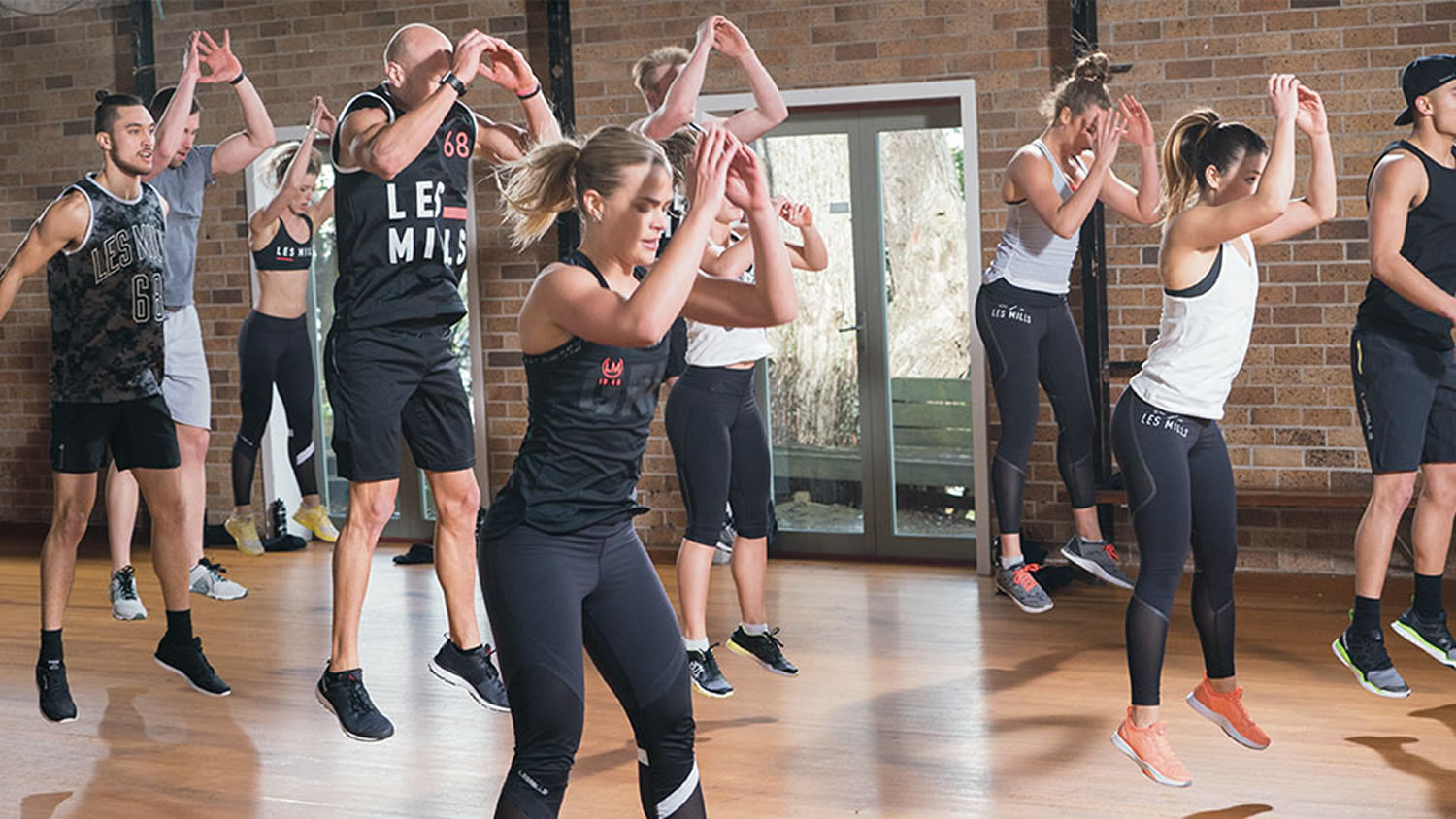
High-intensity interval training causes physiological changes mirroring results of traditional endurance training, but through different pathways 9.
- Endurance training seems to operate through the calcium-calmodulin kinase (CaMK) path.
- HIIT seems to signal via the adenosine monophosphate kinase (AMPK) path.
- Both of these signaling pathways activate PGC-1alpha, a “master switch” in promoting the development of skeletal muscle functions.
There’s solid evidence that older, less active, overweight and obese individuals can benefit from HIIT training. High-intensity interval training has also been shown to be very safe and effective in patients with heart disease and type 2 diabetes. In all of these populations, HIIT programs can produce significant benefit for the cardiovascular system and improved metabolic parameters. And people seem to like it better than traditional endurance exercise.
Low-impact HIIT training options include bicycling, elliptical trainer or water running activities to provide an aerobic exercise challenge without significant joint or impact load. And the intensity, frequency and progression of each program can be tailored to a your medical conditions and physical abilities.
HIIT is also a viable rehabilitation programs to maintain optimum conditioning during injury rehabilitation that appears to be efficient and effective in diverse populations. Incorporating high-intensity interval training into a training program can enhance compliance and provide a time-efficient, enjoyable way for many of our patients to reach their goals.
Higher levels of cardiorespiratory fitness are associated with lower incidence of hypertension in both men and women 17, 18, 19, 20. For example, results from a 15 years follow-up of the CARDIA study showed that each 1-minute decrease in maximal treadmill test duration was associated with a 19% risk of developing hypertension, and suggested that 21% of the hypertension cases could be avoided by increasing cardiorespiratory fitness levels 20. The association between cardiorespiratory fitness and mortality is also consistent. Of all established risk factors, low cardiorespiratory fitness seems to be the strongest predictor of mortality in both healthy and cardiovascular disease subjects 21, 22. Moreover, increased cardiorespiratory fitness has been shown to reduce the risk of mortality even in subjects aged 70 years and older 23, 24.
High-intensity Aerobic Training can Reverse Aging processes in Adults
The findings of a Mayo Clinic study that appear in Cell Metabolism 25 says it’s high-intensity interval training aerobic exercise can reverse some cellular aspects of aging.
The Mayo Clinic study’s goal was to find evidence that will help develop targeted therapies and exercise recommendations for individuals at various ages. Researchers tracked metabolic and molecular changes in a group of young and older adults over 12 weeks, gathering data 72 hours after individuals in randomized groups completed each type of exercise.
General findings showed:
- Cardio respiratory health, muscle mass and insulin sensitivity improved with all training.
- Mitochondrial cellular function declined with age but improved with training.
- Increase in muscle strength occurred only modestly with high-intensity interval training but occurred with resistance training alone or when added to the aerobic training.
- Exercise improves skeletal muscle gene expression independent of age.
- Exercise substantially enhanced the ribosomal proteins responsible for synthesizing new proteins, which is mainly responsible for enhanced mitochondrial function.
- Training has no significant effect on skeletal muscle DNA epigenetic changes but promotes skeletal muscle protein expression with maximum effect in older adults.
The Mayo researchers compared high-intensity interval training, resistance training and combined training. All training types improved lean body mass and insulin sensitivity, but only high-intensity and combined training improved aerobic capacity and mitochondrial function for skeletal muscle. Decline in mitochondrial content and function are common in older adults 26.
High-intensity intervals training also improved muscle protein content that not only enhanced energetic functions, but also caused muscle enlargement, especially in older adults. The researchers emphasized an important finding: Exercise training significantly enhanced the cellular machinery responsible for making new proteins. That contributes to protein synthesis, thus reversing a major adverse effect of aging. However, adding resistance training is important to achieve significant muscle strength.
The authors encourage everyone to exercise regularly, but the take-home message for aging adults that supervised high-intensity intervals training is probably best, because, both metabolically and at the molecular level, it confers the most benefits. The author also added the high-intensity training reversed some manifestations of aging in the body’s protein function. They cautioned that increasing muscle strength requires resistance training a couple of days a week.
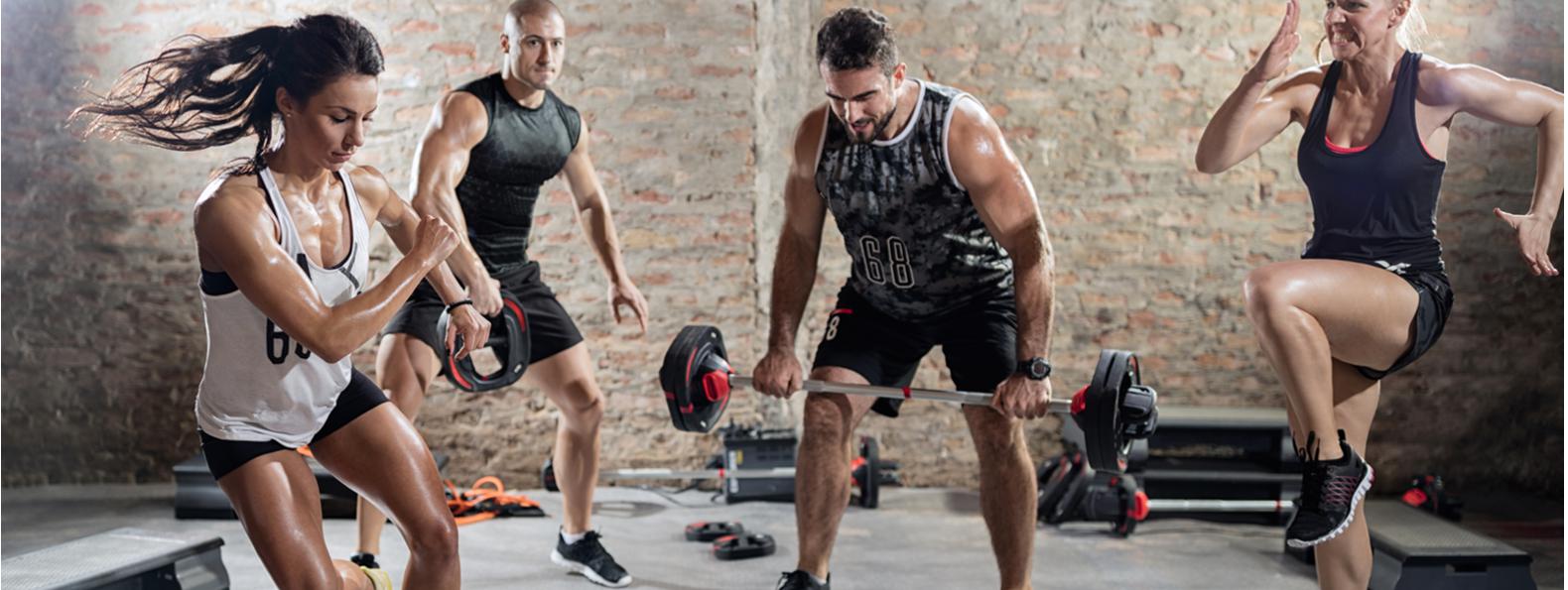
High-Intensity Interval Resistance Training (HIRT) could play a role in Weight Control
High-Intensity Interval Resistance Training (HIRT) can be a fast and efficient way to lose excess body weight and body fat 27, 28, 29, 30. It has been proposed that short period resistance training could play a role in weight control by increasing resting energy expenditure but the effects of different kinds of resistance training has not been widely reported. The incorporated resistance training contributes significantly to the amount of fat burned during a workout 31. When resistance training exercises using multiple large muscles are used with very little rest between sets, they can elicit aerobic and metabolic benefits 32, 5, 28. Research has found that these metabolic benefits can be present for up to 72 hours after a high-intensity exercise bout has been completed 33.
There also may be a greater impact on subcutaneous fat loss with high-intensity intermittent circuit-style resistance training protocols than with traditional steady state sustained-effort aerobic work or traditional resistance training. This is thought to be from the increased level of catecholamines and growth hormone found in the blood both during and after high-intensity resistance training exercise with shortened rest periods (<30 seconds) 34, 28.
Shorter rest periods result in a shorter total exercise time. This is attractive to individuals who are trying to maximize the impact of an exercise program in minimal time.
In a small study involving 17 men doing resistance training, who were separated into doing the High-Intensity Interval Resistance Training (HIRT) consisting of: 6 repetitions, 20 seconds rest, 2/3 repetitions, 20 secs rest, 2/3 repetitions with 2 mins 30 seconds rest between sets, three exercises for a total of 7 sets. And the Traditional Resistance Training consisted of eight exercises of 4 sets of 8–12 repetitions with one/two minutes rest with a total amount of 32 sets. The researchers measured basal resting energy expenditure before the exercise and at 22 hours after the training session.
This data 35 suggest that shorter high-intensity interval resistance training sessions may increase resting energy expenditure at 22 hours after exercise to a greater extent than traditional resistance training and improving fat oxidation. The shorter exercise time commitment may help to reduce one major barrier to exercise.
Effects of High Intensity Interval Training on Cardiorespiratory Fitness and implications for Hypertension
High blood pressure (hypertension) is the most common risk factor for cardiovascular morbidity and mortality, affecting approximately one billion individuals worldwide and is associated with substantial health care expenditure 36, 37.
The association between blood pressure and greater incidence of cardiovascular disease begins with blood pressure levels as low as 115/75 mmHg, and doubles for each 20/10 mmHg increase in systolic/diastolic blood pressure 38.
Regular exercise is a well-established intervention for the prevention and treatment of several chronic diseases, including hypertension 39, 40. Higher levels of physical activity and cardiorespiratory fitness have shown to reduce the risk of hypertension in healthy normotensive persons 41, 42. Moreover, exercise can reduce blood pressure in hypertensive adults 43, 44, 45, 46, and has shown to improve several factors involved in the pathophysiology of hypertension.
There is a close relationship between exercise intensity performed and cardiorespiratory fitness. In this context, HIIT has been shown to be more effective than continuous moderate-intensity exercise training (CMT) for improving cardiorespiratory fitness in different populations 47, 48, 49, 50, 51, 52.
In a pilot study in subjects with metabolic syndrome, which included hypertensive patients, maximal oxygen consumption (VO2 MAX) increased by 35% and 16% after high-intensity interval training and continuous moderate-intensity exercise training, respectively 49. In a study involving a group with young normotensive women at high familial risk for hypertension, greater increases in VO2 MAX were found in HIIT (16%) than continuous moderate-intensity exercise training group (8%) during a 16-wk follow-up. Moreover, HIIT was also more effective than continuous moderate-intensity exercise training for improving several markers of submaximal aerobic capacity, including VO2 at respiratory compensation point, tolerance time to reach anaerobic threshold and tolerance time to reach respiratory compensation point 48. These studies underscore the superiority of high-intensity interval training to improve cardiorespiratory fitness, which may have an important implication for hypertension incidence and mortality risk.
In summary, several studies have shown that high-intensity interval training (HIIT), which consists of several bouts of high-intensity exercise (~85% to 95% of HR MAX and/or VO2 MAX lasting 1 to 4 min interspersed with intervals of rest or active recovery, is superior to continuous moderate-intensity exercise training for improving cardiorespiratory fitness, endothelial function and its markers, insulin sensitivity, markers of sympathetic activity and arterial stiffness in hypertensive and normotensive at high familial risk for hypertension subjects. This compelling evidence suggesting larger beneficial effects of HIIT for several factors involved in the pathophysiology of hypertension raises the hypothesis that HIT may be more effective for preventing and controlling hypertension.
On the hand, the optimum dosage of HIIT still needs to be established. In this context, large trials focused in investigating different combinations of exercise intensity and duration, number of exercise intervals, relative intensity and duration of recovery period between exercise intervals, as well as frequency of training are welcome.
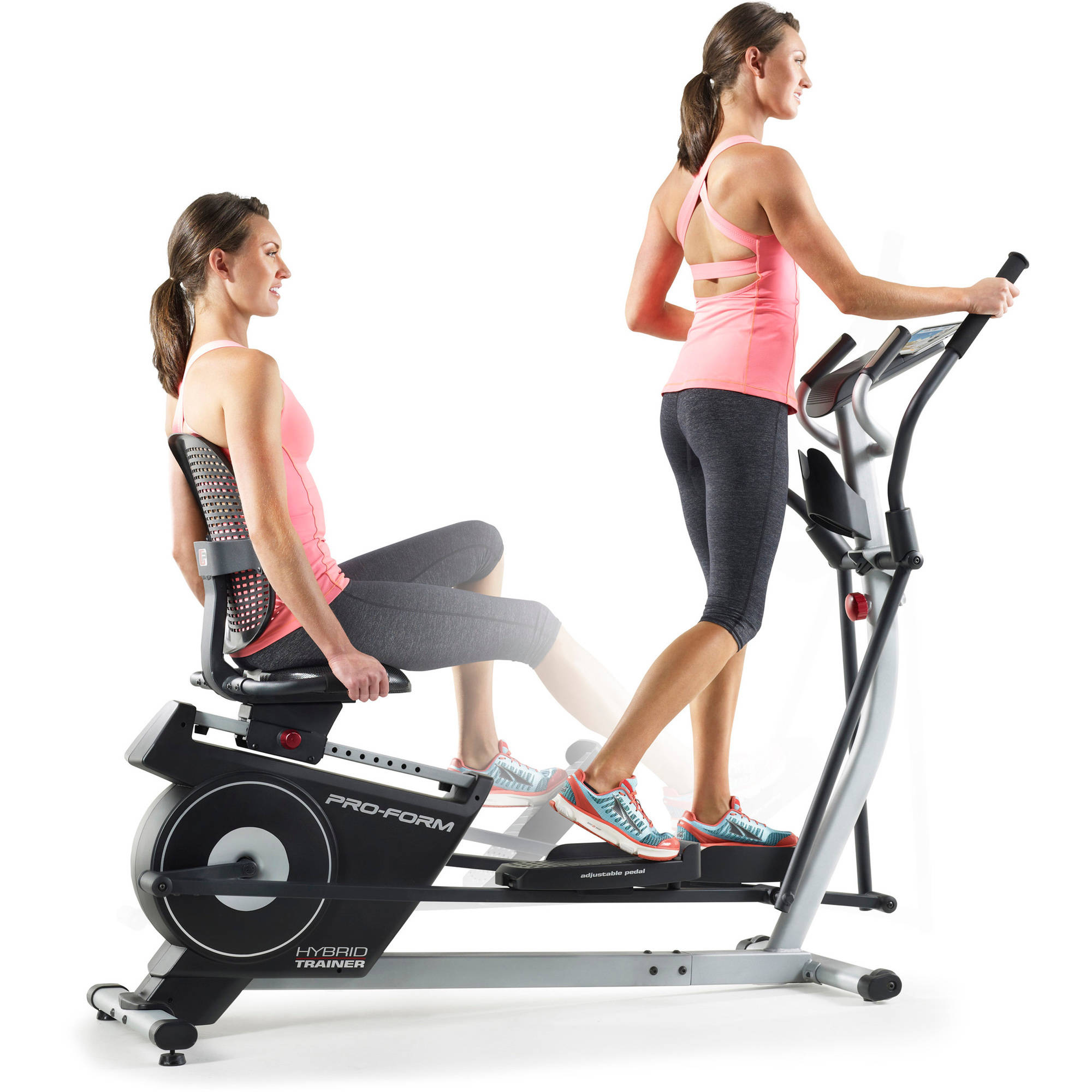
High intensity interval training Improves Liver and Adipose tissue Insulin Sensitivity
Recent studies have indicated that high-intensity interval training (HIIT) lowers blood glucose in individuals with type 2 diabetes independently of weight loss; however, the organs affected and mechanisms mediating the glucose lowering effects are not known 53. High-intensity interval training improved exercise capacity and whole-body glucose homeostasis by enhancing liver and adipose tissue insulin sensitivity. These effects were independent of reductions in adiposity/adipose tissue cell size indicating the therapeutic potential of exercise independent of weight loss.
Improved insulin sensitivity was also independent of adipose tissue inflammation, macrophage infiltration/inflammation or reductions in liver lipid content indicating dissociation between these parameters and insulin resistance.
The efficacy of a high intensity exercise protocol, involving only ~250 kcal of work each week, can substantially improve insulin action in young sedentary subjects is remarkable 54. Lastly, the research authors also demonstrated that in contrast to metformin (a drug that is used to treat type 2 diabetes), HIIT exercise training improves insulin sensitivity independently of the AMPK-ACC signaling pathway. Future studies identifying the mechanism by which HIIT improves insulin sensitivity may reveal novel strategies to improve glucose homeostasis in individuals with type 2 diabetes.
What can High Intensity Interval Training (HIIT) do for you ?
Whether you’re a novice exerciser or you’ve been exercising for years, high intensity interval training can help you jazz up your workout routine. Consider the benefits:
- You’ll burn more calories. The more vigorously you exercise, the more calories you’ll burn — even if you increase intensity for just a few minutes at a time.
- You’ll improve your aerobic capacity. As your cardiovascular fitness improves, you’ll be able to exercise longer or with more intensity. Imagine finishing your 60-minute walk in 45 minutes — or the additional calories you’ll burn by keeping up the pace for the full 60 minutes.
- You’ll keep boredom at bay. Turning up your intensity in short intervals can add variety to your exercise routine.
- You don’t need special equipment. You can simply modify your current routine.
If you simply want to vary your exercise routine, you can determine the length and speed of each high-intensity interval based on how you feel that day.
After warming up, you might increase the intensity for 30 seconds and then resume your normal pace. The next burst of more intense activity may last two to three minutes. How much you pick up the pace, how often and for how long is up to you.
If you’re working toward a specific fitness goal, you may want to take a more scientific approach. A personal trainer or other expert can help you time the intensity and duration of your intervals — which may include movement patterns similar to those you’ll use during your sport or activity — based on your target heart rate, the ability of your heart and lungs to deliver oxygen to your muscles (VO2 max or peak oxygen intake), and other factors.

High Intensity Interval Training Workouts for Beginners
Yes anyone can enjoy and benefit from HIIT and you can take interval training to many levels. High intensity interval training can be used effectively by athletes, as well as people of all ages and fitness levels, including people with serious diseases, such as coronary heart disease and chronic heart failure. If you simply want to vary your exercise routine, you can determine the length and speed of each high-intensity interval based on how you feel that day.
Before you begin HIIT, exercise at moderate intensity only for several workout sessions until you can exercise continuously at that level for at least 20 minutes.
You can use whatever form of aerobic exercise you prefer.
- Walking,
- Jogging,
- Biking or
- Working out on an exercise machine, such as an elliptical trainer, are all good choices.
The first time you use HIIT, warm up for five minutes at a relatively easy pace. Then move to a moderate pace for about five to 10 minutes. After that, switch to a high-intensity pace for 30 seconds, then reduce your pace to back moderate for one to three minutes to allow yourself to recover completely.
OR
After warming up, you might increase the intensity for 30 seconds and then resume your normal pace. The next burst of more intense activity may last two to three minutes. How much you pick up the pace, how often and for how long is up to you.
Repeat the high-intensity pace and moderate-intensity recovery phases two or three times during a 30-minute exercise session.
When you are exercising at the higher intensity, you should be pushing yourself, but you don’t need to be working at your maximum effort. During your exercise session, you should not experience symptoms such as chest pain or discomfort, severe shortness of breath or lightheadedness. If you do, stop exercising right away. You also should not have unusual fatigue, muscle pain or joint pain that lasts a long time after you exercise. Talk to your health care provider about any of these symptoms or about other symptoms you have during exercise that seem out of the ordinary.
As you become accustomed to HIIT and your fitness improves, increase the number of times you switch between high-intensity and moderate-intensity to five or six per workout. You also can increase the amount of time you stay at the high-intensity pace to one to two minutes as you are able. Even as you become more fit, include HIIT in only two or three of your exercise sessions per week. Those sessions should not be on consecutive days.
If you’re working toward a specific fitness goal, you may want to take a more scientific approach. A personal trainer or other expert can help you time the intensity and duration of your intervals — which may include movement patterns similar to those you’ll use during your sport or activity — based on your target heart rate, the ability of your heart and lungs to deliver oxygen to your muscles (peak oxygen intake), and other factors 55.
Does interval training have risks ?
Interval training isn’t appropriate for everyone. If you have a chronic health condition or haven’t been exercising regularly, consult your doctor before trying any type of interval training. Recent studies suggest, however, that interval training can be used safely for short periods even in individuals with heart disease.
Also keep the risk of overuse injury in mind. If you rush into a strenuous workout before your body is ready, you may injure your muscles, tendons or bones. Instead, start slowly. Try doing just one or two higher intensity intervals during each workout at first. If you think you’re overdoing it, slow down. As your stamina improves, challenge yourself to vary the pace. You may be surprised by the results.
Summary
High intensity means using as much energy as you can during exercise in a small amount of time. You need to train hard enough that the workout is at least moderately uncomfortable. If you’re able to hold a conversation during the work periods, you’re probably not training hard enough. A typical HIIT session might include a three-minute warmup, four to six repetitions of a 30-second sprint followed by a 60-second active recovery, and a three-minute cool-down.
With HIIT, you’ll lose weight, build muscle, and boost your metabolism. Plus there’s a post-workout bonus: Your body will burn calories for about 2 hours after you exercise.
There’s solid evidence that older, less active, overweight and obese individuals can benefit from HIIT training. High-intensity interval training has also been shown to be very safe and effective in patients with heart disease and type 2 diabetes. In all of these populations, HIIT programs can produce significant benefit for the cardiovascular system and improved metabolic parameters. Getting and staying fit is part of managing conditions like type 2 diabetes, high blood pressure, high cholesterol, or heart disease. And HIIT is a great way to lose weight and boost your overall health.
Recent research has shown that HIIT can promote improvements in blood glucose control involving only ~250 kcal of work each week, to substantially improve insulin action in young sedentary and cardiovascular health in individuals with type 2 diabetes subjects. This novel time-efficient training paradigm can be used as a strategy to reduce metabolic risk factors in young and middle aged sedentary populations who otherwise would not adhere to time consuming traditional aerobic exercise regimes.
However, fundamental questions remain regarding the minimum volume of exercise necessary to improve physiological well-being in various populations, the effectiveness of alternative (less extreme) interval-training strategies, and the precise nature and magnitude of adaptations that can be elicited and maintained over the long-term. A comprehensive evaluation of the physiological adaptations induced by different interval-training strategies in a wide range of populations will permit evidence-based recommendations that may provide an alternative to current exercise prescriptions for time-pressed individuals.
- Kessler HS, Sisson SB, Short KR. The potential for high-intensity interval training to reduce cardiometabolic disease risk. Sports Med. 2012;42(6):489–509. doi: 10.2165/11630910-0. https://www.ncbi.nlm.nih.gov/pubmed/22587821[↩]
- Exerc Sport Sci Rev. 2008 Apr;36(2):58-63. doi: 10.1097/JES.0b013e318168ec1f. – Metabolic Adaptations to Short-term High-Intensity Interval Training: A Little Pain for a Lot of Gain ?. – http://journals.lww.com/acsm-essr/fulltext/2008/04000/Metabolic_Adaptations_to_Short_term_High_Intensity.3.aspx[↩]
- American College of Sports Medicine. The Basics of High-Intensity Interval Training. https://certification.acsm.org/blog/2015/may/the-basics-of-high-intensity-interval-training[↩][↩]
- American College of Sports Medicine. High-Intensity Interval Training. https://www.acsm.org/docs/brochures/high-intensity-interval-training.pdf[↩][↩][↩]
- Haltom R, Kraemer RR, Sloan RA, Frank K, Tryniecki JL. Circuit weight training and its effects on excess postexercise oxygen consumption. Med Sci Sports Exerc. 1999; 31: 1202–7.[↩][↩]
- Little JP, Safdar A, Wilkin GP, Ranopolsky MA, Gibala MJ. A practical model of low-volume high-intensity interval training induces mitochondrial biogenesis in human skeletal muscle: potential mechanisms. J Physiol. 2010;588:1011–22.[↩]
- Tabata I, Nishimura K, Kouzaki M, et al. Effects of moderate-intensity endurance and high-intensity intermittent training on anaerobic capacity and VO2max. Med Sci Sports Exerc. 996;28(10):1327–30.[↩][↩][↩]
- Richards JC, Johsnon TK, Kuzma JN, Lonac MC, Schweder MM, Voyles WF, Bell C. J Physiol. 2010;588:2961–72.[↩]
- Mayo Foundation for Medical Education and Research. Sprint, rest, repeat: Exploring the benefits of high-intensity interval training. http://www.mayoclinic.org/medical-professionals/clinical-updates/physical-medicine-rehabilitation/sprint-rest-repeat-exploring-the-benefits-of-high-intensity-interval-training[↩][↩]
- Gibala MJ, Little JP. Just HIT it! A time-efficient exercise strategy to improve muscle insulin sensitivity. J Physiol. 2010; 588 (18): 3341–2.[↩][↩]
- Garber CE, Blissmer B, Deschenes MR, et al.. Quantity and quality of exercise for developing and maintaining cardiorespiratory, musculoskeletal, and neuromotor fitness in apparently healthy adults: guidance for prescribing exercise. Med Sci Sports Exerc. 2011; 43 (7): 1334–59.[↩]
- American College of Sports Medicne. HIGH-INTENSITY CIRCUIT TRAINING USING BODY WEIGHT: Maximum Results With Minimal Investment. http://journals.lww.com/acsm-healthfitness/Fulltext/2013/05000/HIGH_INTENSITY_CIRCUIT_TRAINING_USING_BODY_WEIGHT_.5.aspx[↩]
- High-intensity interval training, solutions to the programming puzzle: Part I: cardiopulmonary emphasis. Buchheit M, Laursen PB Sports Med. 2013 May; 43(5):313-38. https://www.ncbi.nlm.nih.gov/pubmed/23539308/[↩]
- Sports Med. 2014; 44(7): 1005–1017. Effects of Low-Volume High-Intensity Interval Training (HIT) on Fitness in Adults: A Meta-Analysis of Controlled and Non-Controlled Trials. https://www.ncbi.nlm.nih.gov/pmc/articles/PMC4072920/[↩]
- [↩]
- PLoS One. 2013; 8(9): e73182. VO2max Trainability and High Intensity Interval Training in Humans: A Meta-Analysis. https://www.ncbi.nlm.nih.gov/pmc/articles/PMC3774727/[↩]
- The association of cardiorespiratory fitness and physical activity with incidence of hypertension in men. Am J Hypertens. 2009;22:417–424. https://www.ncbi.nlm.nih.gov/pubmed/19197248[↩]
- Chase NL, Sui X, Lee D, Blair S. Blair SN, Goodyear NN, Gibbons LW, Cooper KH. Physical fitness and incidence of hypertension in healthy normotensive men and women. JAMA. 1984;252:487–490. https://www.ncbi.nlm.nih.gov/pubmed/6737638[↩]
- Barlow CE, LaMonte MJ, FitzGerald SJ, Kampert JB, Perrin JL, Blair SN. Cardiorespiratory fitness is an independent predictor of hypertension incidence among initially normotensive healthy women. Am J Epidemiol. 2006;163:142–150. https://www.ncbi.nlm.nih.gov/pubmed/16293717[↩]
- Carnethon MR, Gidding SS, Nehgme R, Sidney S, Jacobs DR Jr, Liu K. Cardiorespiratory fitness in young adulthood and the development of cardiovascular disease risk factors. JAMA. 2003;290:3092–3100. https://www.ncbi.nlm.nih.gov/pubmed/14679272[↩][↩]
- Myers J, Prakash M, Froelicher V, Do D, Partington S, Atwood JE. Exercise capacity and mortality among men referred for exercise testing. N Engl J Med. 2002;346:793–801. https://www.ncbi.nlm.nih.gov/pubmed/11893790[↩]
- Keteyian SJ, Brawner CA, Savage PD, Ehrman JK, Schairer J, Divine G, Aldred H, Ophaug K, Ades PA. Peak aerobic capacity predicts prognosis in patients with coronary heart disease. Am Heart J. 2008;156:292–300. https://www.ncbi.nlm.nih.gov/pubmed/18657659[↩]
- Blair SN, Kohl HW III, Barlow CE, Paffenbarger RS Jr, Gibbons LW, Macera CA. Changes in physical fitness and all-cause mortality. A prospective study of healthy and unhealthy men. JAMA. 1995;273:1093–1098. https://www.ncbi.nlm.nih.gov/pubmed/7707596[↩]
- Kokkinos P, Myers J, Faselis C, Panagiotakos DB, Doumas M, Pittaras A, Manolis A, Kokkinos JP, Karasik P, Greenberg M, Papademetriou V, Fletcher R. Exercise capacity and mortality in older men: a 20-year follow-up study. Circulation. 2010;122:790–797. https://www.ncbi.nlm.nih.gov/pubmed/20697029[↩]
- Cell Metabolism Volume 25, Issue 3, p581–592, 7 March 2017. Enhanced Protein Translation Underlies Improved Metabolic and Physical Adaptations to Different Exercise Training Modes in Young and Old Humans. http://www.cell.com/cell-metabolism/fulltext/S1550-4131(17)30099-2[↩]
- Mayo Clinic March 10, 2017. Mayo Clinic discovers high-intensity aerobic training can reverse aging processes in adults. http://newsnetwork.mayoclinic.org/discussion/mayo-clinic-discovers-high-intensity-aerobic-training-can-reverse-aging-processes-in-adults/[↩]
- Gibala MJ, Little JP, Essen MV, et al.. Short-term sprint interval versus traditional endurance training: similar initial adaptations in human skeletal muscle and exercise performance. J Physiol. 2006; 575 (3): 901–11.[↩]
- Murphy E, Schwarzkopf R. Effects of standard set and circuit weight training on excess post-exercise oxygen consumption. J Strength Cond Res. 1992;6(2):66–124.[↩][↩][↩]
- Trapp EG, Chisholm DJ, Fruend J, Bouthcher SH. The effects of high-intensity intermittent exercise training on fat loss and fasting insulin levels of young women. Int J Obes. 2008;32(4):684–91.[↩]
- Wernbom M, Augustsson J, Thomee R. The influence of frequency, intensity, volume and mode of strength training on whole muscle cross-sectional area in humans. Sports Med. 2007;37(3):225–64. https://www.ncbi.nlm.nih.gov/pubmed/17326698[↩]
- Scott CB, Leighton BH, Ahearn KJ, McManus JJ. Aerobic, anaerobic, and excess postexercise oxygen consumption energy expenditure of muscular endurance and strength: 1-set of bench press to muscular fatigue. J Strength Cond Res. 2011;25(4):903–8. https://www.ncbi.nlm.nih.gov/pubmed/20703175 [↩]
- Elliot DL, Goldberg L, Kuehl KS. Effects of resistance training on excess post-exercise O2 consumption. J Appl Sports Sci Res. 1992; 6: 77–81.[↩]
- Heden L, Lox C, Rose P, Reid S, Kirk EP. One set resistance training elevates energy expenditure for 72 hours similar to three sets. Eur J Appl Physiol. 2011; 111 (3): 477–84.[↩]
- Moller N, Schmitz O, Porksen N, Moller J, Jorgenson JO. Dose-response studies on the metabolic effects of a growth hormone pulse in humans. Metabolism. 1992;41(2):172–5. https://www.ncbi.nlm.nih.gov/pubmed/1736039[↩]
- J Transl Med. 2012; 10: 237. High-Intensity Interval Resistance Training (HIRT) influences resting energy expenditure and respiratory ratio in non-dieting individuals. https://www.ncbi.nlm.nih.gov/pmc/articles/PMC3551736/[↩]
- Chobanian AV, Bakris GL, Black HR, Cusnhiman WC, Green LA, Izzo JI Jr, Jones DW, Materson BJ, Oparil S, Wright JT Jr, Roccella EJ. National Heart, Lung, and Blood Institute Joint National Committee on Prevention, Detection, Evaluation, and Treatment of High Blood Pressure; National High Blood Pressure Education Program Coordinating Committee. The Seventh Report of the Joint National Committee on Prevention, Detection, Evaluation, and Treatment of High Blood Pressure. Hypertension. 2003;42:1206–1252. https://www.ncbi.nlm.nih.gov/pubmed/14656957[↩]
- Lawes CM, Vander Hoorn S, Rodgers A. Global burden of blood pressure-related disease, 2001. Lancet. 2008;371:1513–1518. https://www.ncbi.nlm.nih.gov/pubmed/18456100[↩]
- Lewington S, Clarke R, Qizilbash N, Peto R, Collins R. Age-specific relevance of usual blood pressure to vascular mortality: a meta-analysis of individual data for one million adults in 61 prospective studies. Lancet. 2002;360:1903–1913. https://www.ncbi.nlm.nih.gov/pubmed/12493255[↩]
- Haskell WL, Lee IM, Pate RR, Powell KE, Blair SN, Franklin BA, Macera CA, Heath GW, Thompson PD, Bauman A. Physical activity and public health: Updated recommendation for adults from the American College of Sports Medicine and the American Heart Association. Circulation. 2007;116:1081–1093. https://www.ncbi.nlm.nih.gov/pubmed/17671237[↩]
- American College of Sports Medicine. Position stand: exercise and hypertension. Med Sci Sports Exerc. 2004;36:533–553. https://www.ncbi.nlm.nih.gov/pubmed/15076798[↩]
- Hayashi T, Tsumura K, Suematsu C, Okada K, Fujii S, Endo G. Walking to work and the risk for hypertension in men: the Osaka Health Survey. Ann Intern Med. 1999;131:21–26. https://www.ncbi.nlm.nih.gov/pubmed/10391811[↩]
- Chase NL, Sui X, Lee D, Blair S. The association of cardiorespiratory fitness and physical activity with incidence of hypertension in men. Am J Hypertens. 2009;22:417–424. https://www.ncbi.nlm.nih.gov/pubmed/19197248[↩]
- Ciolac EG, Guimarães GV, D’Ávila VM, Bortolotto LA, Doria EL, Bocchi EA. Acute effects of continuous or interval aerobic exercise on 24-h ambulatory blood pressure of long-term treated hypertensive. Int J Cardiol. 2009;133:381–387. https://www.ncbi.nlm.nih.gov/pubmed/18501444[↩]
- Ciolac EG, Guimarães GV, D’Ávila VM, Dória E, Bocchi EA. Acute aerobic exercise reduces 24-h ambulatory blood pressure levels in long-term-treated hypertensive patients. Clinics. 2008;63:753–758. https://www.ncbi.nlm.nih.gov/pmc/articles/PMC2664274/[↩]
- Pescatello LS, Kulikowich JM. The aftereffects of dynamic exercise on ambulatory blood pressure. Med Sci Sports Exerc. 2001;33:1855–1861. https://www.ncbi.nlm.nih.gov/pubmed/11689735[↩]
- Guimarães GV, Ciolac EG, Carvalho VO, D’Ávila VM, Bortolotto LA, Bocchi EA. Effects of continuous vs. interval exercise training on blood pressure and arterial stiffness in treated hypertension. Hypert Res. 2010;33:627–632. https://www.ncbi.nlm.nih.gov/pubmed/20379194[↩]
- Ciolac EG, Bocchi EA, Bortolotto LA, Carvalho VO, Greve JMD, Guimarães GV. Effects of high-intensity aerobic interval training vs. moderate exercise on hemodynamic, metabolic and neuro-humoral abnormalities of young normotensive women at high familial risk for hypertension. Hypert Res. 2010;33:836–843. https://www.ncbi.nlm.nih.gov/pubmed/20448634[↩]
- Ciolac EG, Bocchi EA, Greve JMD, Guimarães GV. Heart rate response to exercise and cardiorespiratory fitness of young women at high familial risk for hypertension: effects of interval vs continuous training. Eur J Cardiov Prev Rehabil. 2011;18:824–830. https://www.ncbi.nlm.nih.gov/pubmed/21450597[↩][↩]
- Tjønna AE, Lee SJ, Rognmo Ø, Stølen TO, Bye A, Haram PM, Loennechen JP, Al-Share QY, Skogvoll E, Slørdahl SA, Kemi OJ, Najjar SM, Wisløff U. Aerobic interval training versus continuous moderate exercise as a treatment for the metabolic syndrome. A pilot study. Circulation. 2008;118:346–354. https://www.ncbi.nlm.nih.gov/pmc/articles/PMC2777731/[↩][↩]
- Helgerud J, Hoydal K, Wang E, Karlsen T, Berg P, Bjerkaas M, Simonsen T, Helgesen C, Hjorth N, Bach R, Hoff J. Aerobic high intensity intervals improve VO2max more than moderate training. Med Sci Sports Exerc. 2007;39:665–671. https://www.ncbi.nlm.nih.gov/pubmed/17414804[↩]
- Rognmo O, Hetland E, Helgerud J, Hoff J, Slordahl SA. High intensity aerobic interval exercise is superior to moderate intensity exercise for increasing aerobic capacity in patients with coronary artery disease. Eur J Cardiovasc Prev Rehabil. 2004;11:216–222. https://www.ncbi.nlm.nih.gov/pubmed/15179103[↩]
- Wisloff U, Stoylen A, Loennechen JP, Bruvold M, Rognmo O, Haram PM, Tjønna AE, Helgerud J, Slørdahl SA, Lee SJ, Videm V, Bye A, Smith GL, Najjar SM, Ellingsen O, Skjærpe T. Superior cardiovascular effect of aerobic interval training versus moderate continuous training in heart failure patients: a randomized study. Circulation. 2007;115:3086–3094. https://www.ncbi.nlm.nih.gov/pubmed/17548726[↩]
- Mol Metab. 2015 Dec; 4(12): 903–915. – High intensity interval training improves liver and adipose tissue insulin sensitivity- https://www.ncbi.nlm.nih.gov/pmc/articles/PMC4731736/[↩]
- BMC Endocr Disord. 2009; 9: 3. – Extremely short duration high intensity interval training substantially improves insulin action in young healthy males – https://www.ncbi.nlm.nih.gov/pmc/articles/PMC2640399/[↩]
- Mayo Foundation for Medical Education and Research. Are the principles of interval training the same for everyone ?. http://www.mayoclinic.org/healthy-lifestyle/fitness/in-depth/interval-training/art-20044588?pg=2[↩]
